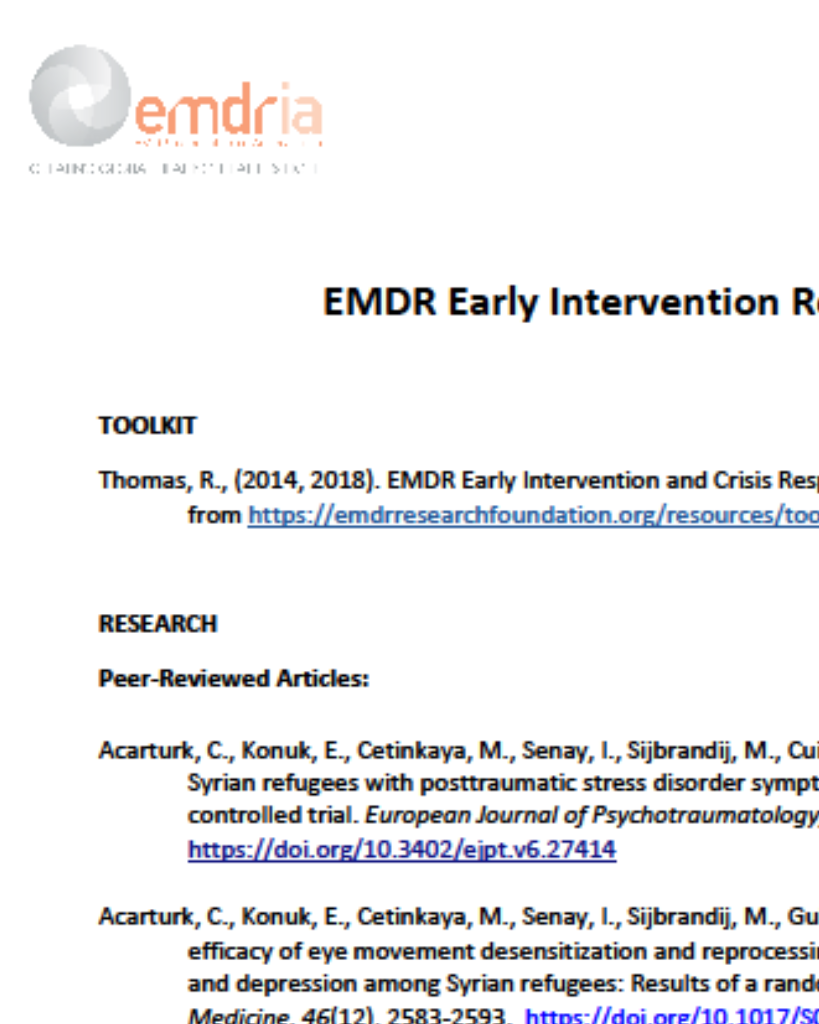Eye movement desensitization (EMD) to reduce posttraumatic stress disorder-related stress reactivity in Indonesia PTSD patients: A study protocol for a randomized controlled trial
Study testing whether eye movements provided during Eye Movement Desensitization (EMD) are effective in reducing stress reactivity in PTSD.
Article Abstract
“Background: Posttraumatic stress disorder (PTSD) may develop after exposure to a traumatic event. Eye Movement Desensitization and Reprocessing (EMDR) is an evidence-based psychological treatment for PTSD. It is yet unclear whether eye movements also reduce stress reactivity in PTSD patients. This study aims to test whether eye movements, as provided during Eye Movement Desensitization (EMD), are more effective in reducing stress reactivity in PTSD patients as compared to a retrieval-only control condition.
Methods: The study includes participants who meet criteria of PTSD of the public psychological services in Jakarta and Bandung, Indonesia. One hundred and ten participants are randomly assigned to either an (1) Eye Movement Desensitization group (n = 55) or (2) retrieval-only control group (n = 55). Participants are assessed at baseline (T0), post-treatment (T1), 1 month (T2), and at 3 months follow-up (T3). Participants are exposed to a script-driven imagery procedure at T0 and T1. The primary outcome is heart rate variability (HRV) stress reactivity during script-driven imagery. Secondary outcomes include heart rate (HR), pre-ejection period (PEP), saliva cortisol levels, PTSD symptoms, neurocognitive functioning, symptoms of anxiety and depression, perceived stress level, and quality of life.
Discussion: If the EMD intervention is effective in reducing stress reactivity outcomes, this would give us more insight into the underlying mechanisms of EMDR’s effectiveness in PTSD symptom reduction.”
—Description from publisher
Article Access
Open Access
Susanty, E., Sijbrandij, M., Srisayekti, W., & Huizink, A. C. (2021). Eye movement desensitization (EMD) to reduce posttraumatic stress disorder-related stress reactivity in Indonesia PTSD patients: A study protocol for a randomized controlled trial. Trials 22, 181. Open access: https://doi.org/10.1186/s13063-021-05100-3
Date
March 4, 2021
Creator(s)
Eka Susanty, Marit Sijbrandij, Wilis Srisayekti
Contributor(s)
Anja C. Huizink
Topics
PTSD
Practice & Methods
Protocols
Extent
12 pages
Publisher
BMC
Rights
© The Author(s). 2021 Open Access This article is licensed under a Creative Commons Attribution 4.0 International License, which permits use, sharing, adaptation, distribution and reproduction in any medium or format, as long as you give appropriate credit to the original author(s) and the source, provide a link to the Creative Commons licence, and indicate if changes were made. The images or other third party material in this article are included in the article's Creative Commons licence, unless indicated otherwise in a credit line to the material. If material is not included in the article's Creative Commons licence and your intended use is not permitted by statutory regulation or exceeds the permitted use, you will need to obtain permission directly from the copyright holder. To view a copy of this licence, visit http://creativecommons.org/licenses/by/4.0/. The Creative Commons Public Domain Dedication waiver (http://creativecommons.org/publicdomain/zero/1.0/) applies to the data made available in this article, unless otherwise stated in a credit line to the data.
APA Citation
Susanty, E., Sijbrandij, M., Srisayekti, W., & Huizink, A. C. (2021). Eye movement desensitization (EMD) to reduce posttraumatic stress disorder-related stress reactivity in Indonesia PTSD patients: A study protocol for a randomized controlled trial. Trials 22, 181. Open access: https://doi.org/10.1186/s13063-021-05100-3
Audience
EMDR Therapists, Other Mental Health Professionals
Language
English
Content Type
Article, Peer-Reviewed, RCT
Access Type
External Resource, Open Access





